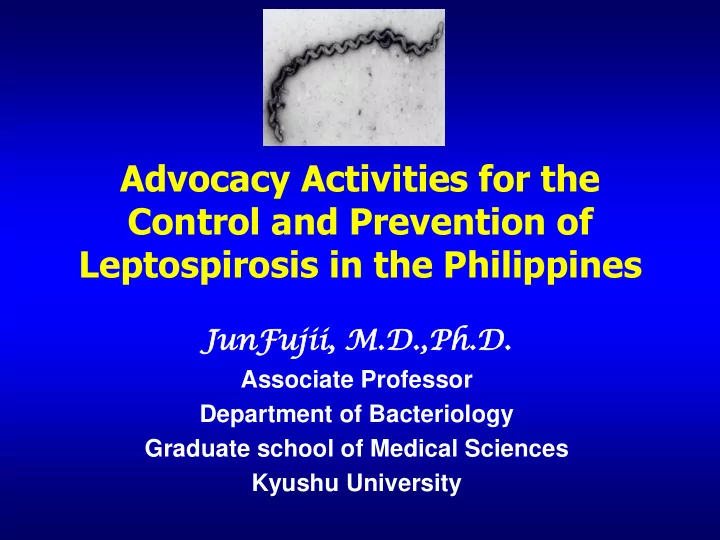

Advocacy Activities for the Control and Prevention of Leptospirosis in the Philippines Jun unFu Fuji jii, M.D.,Ph.D. D. Associate Professor Department of Bacteriology Graduate school of Medical Sciences Kyushu University
What is leptospirosis? • Leptospirosis is a bacterial disease that affects humans and animals. • It is caused by bacteria of the genus Leptospira . • If not treated, the patient could develop kidney damage, meningitis, liver failure, and respiratory distress or death. Symptoms: -high fever -severe headache -muscle pains -vomiting -jaundice (yellow skin and eyes) -red eyes
History of leptospirosis Dr. Adolf Weil described leptospirosis as a disease entity in 1886. His name is still attached to a serious form of leptospirosis called Weil's disease. Leptospires were recognized by Dr.Ryokichi Inada in Kyushu University in Japan.
1915: discovery of leptospires Dr. Inada and colleagues of Kyushu University reported Leptospira as the causative agent of leptospirosis. He is the first professor of department of first internal medicine. The centennial of the leptosires discovery is scheduled in 2013 in Kyushu University Dr. Inada
Prevalence of Leptospirosis
How do people get leptospirosis? Humans become infected through contact with water, or soil contaminated with urine of infected animals like rodents (rats and mice). Estimated number of annual cases: 350,000 to 500,000, 5,779 deaths in 10 years (1999 World Health Organization & International Leptospirosis Society survey) flood in Philippines
Epidemiology in Philippines Leptospirosis outbreak after Typhoon ‘ Ondoy ’ reported on Nov 6, 2009: - 3, 125 cases from National Capital Region (NCR), Regions I, II, III, IV-A and Cordillera Autonomous Region (CAR) - 240 mortality (Case Fatality Rate= 7.6%)
LEPCON project has started this year
Collaborative Framework for the Control and Prevention of Leptospirosis in the Philippines Department of Health Kyushu U, Chiba U ~400 Sentinel Sites Other Referring Hospitals UP Manila CPH & health care institutions Philippine Carabao Center UP Mindanao UP Visayas West Visayas Davao Medical Center Medical Center With Support from DOST, WHO, JICA, JST
Purpose of LEPCON Research and development (R&D) capacity of College of Public Health (CPH-UPM) is enhanced for prevention and control of leptospirosis through the collaborative research Project Leader: Professor Shin-ichi Yoshida, Department of Bacteriology, Graduate School of Medical Sciences, Kyushu University
Output of the LEPCON Advocacy Burden of Disease by Bacteriological study Center for LEPCON Development of Diagnostic kits and DNA vaccines Epidemiology and Economic burden
Plan of Operation/Project Design Matrix and Working group in Japan and Philippines Group A: Microbiology 0. Laboratory Renovation 1)Bacterial surveillance 2) Diagnostic kit 1. Epidemiology 3) DNA vaccine 1) Bacteriological surveillance 2) Burden of disease 3) Environmental risk factors Group B: Burden of disease 2. Diagnostic kit Group C: Environmental risk factors 3. DNA vaccine Group D: Advocacy Fujii/ Guevarra 4. Advocacy
Advocacy Activity • To confirm the target hospitals and health centers. • To collect data on the knowledge on leptospirosis from clinicians, nurses, and other health workers. • To develop materials such as handbook or leaflets on leptospirosis for clinicians, nurses, and other health workers. • To capacitate the clinicians, nurses, and other health workers, and distribute materials. • To disseminate knowledge on leptospirosis to the public. • To conduct evaluation of advocacy activities. • To organize scientific meetings, workshops or fora to present the progress and results of the project and for advocacy to policy makers for future leptospirosis control
How do we use the Asia-Pacific Advanced Network? • Real-time conference on leptospirosis among collaborating institutes for the advocacy activity. • Exchange of information regarding laboratory high technologies such as microarray, proteomics and vaccine development in Kyushu University. • Medical education including diagnosis and therapeutic methods of leptospirosis to the doctor and nurse in Japan and Philippines • Finally, we ask to connect Asia-Pacific Advanced Network between Faculty of Medical Sciences Building B Basic Sciences, Kyushu University and Lara Hall, College of Public Health, University of the Philippines Manila by APAN engineers.
Faculty of Medical Sciences Building B Basic Sciences Kyushu University
Lara Hall, College of Public Health, University of the Philippines Manila
Upgrading of Leptospirosis Laboratory through JICA Grant
Upgrading of Leptospirosis Laboratory through JICA Grant
Recommend
More recommend